VERKLARTE NACHT
Laura Berger, Sasha Ferré, Genevieve Cohn, Jonathan Ryan, Alexis Jang
Zwei Menschen gehn durch hohe, helle Nacht
(Two people walk through the lofty, bright night).
A simple and yet enigmatic verse ends the poem by the German poet Richard Dehmel, published in the book Wein und Welt in 1896 with the title Verklärte Nacht, “transfigured night”. Three years later, Arnold Schönberg would compose a symphonic piece after Dehmel’s poem, setting dramas and doubts of a love story to music, a story based on the secret a woman reveals to his lover on a winter night. The five artists challenge the traditional musical, literary and artistic genre of the nocturne, primarily spread in the XVIII century, and they merge in the blue shades of night recreating the atmosphere of the darkest hours, constantly reinventing reality through the encounter and overlap between the oneiric and natural realm.
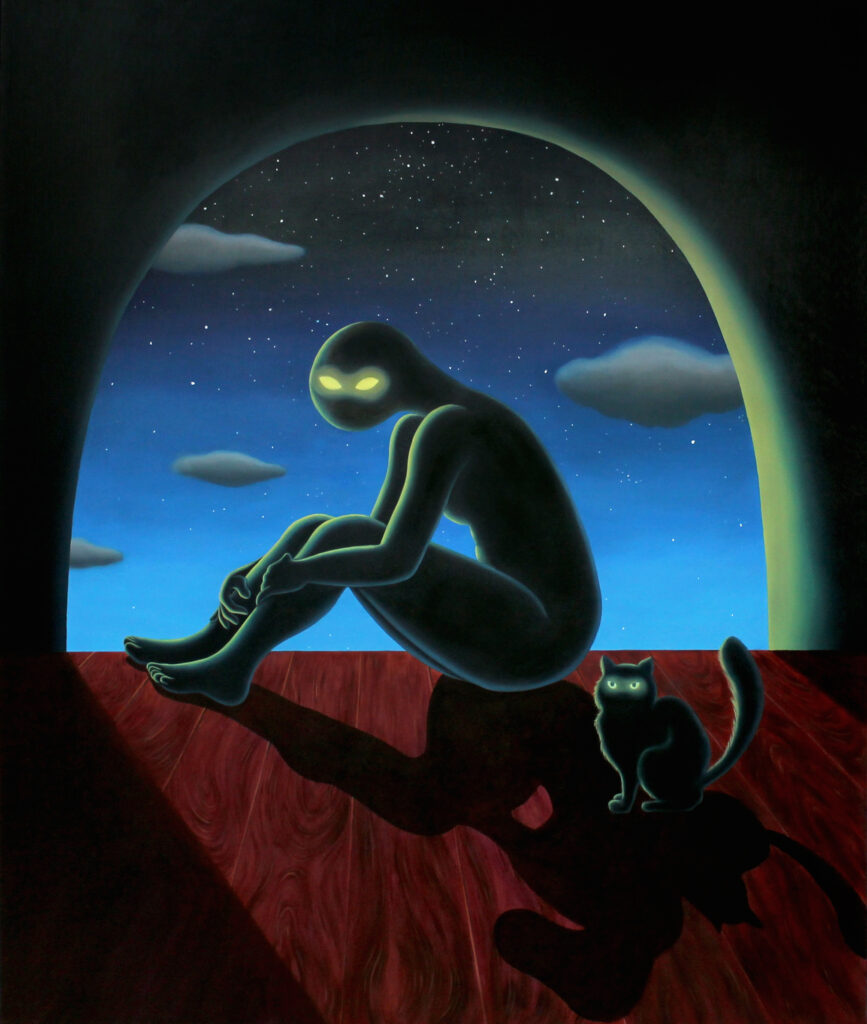
Alexis Jang
Four Clouds, 2022-2023
Oil on Canvas
cm 100×120
SOLD

Alexis Jang
Windswept Bonnet, 2022-2023
Oil on Canvas
cm 100×120
SOLD
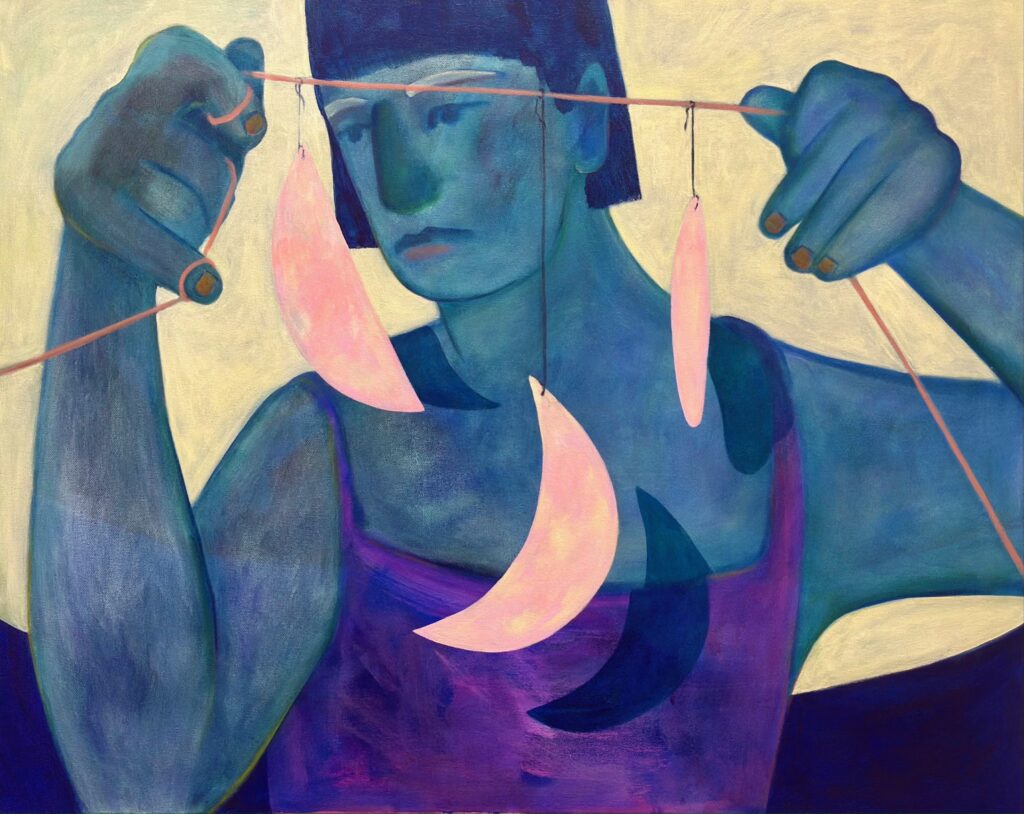
Genevieve Cohn
How to Hold a History, 2022
Acrylic on canvas
cm 60,96 x 76
SOLD
With her works Night thoughts and Sleepwalkers Laura Berger focuses on the psychic phenomena of sleep by representing a sort of anthropomorphic night. The night-time gives space to the unconscious and a second life begins in dreams. In Berger’s works, the minutes and hours of night are living ghost-like character of a sleeping world, which can strangle or stroke the dreamer. The female figures who often appear in her works wander in the darkness, sleepwalkers who walk the unpredictable paths of personal inner places while waiting for dawn. From Berger’s psychosomatic night we then move on to the mystical and archaic vibe of Genevieve Cohn‘s painting, who represents the night as a mysterious and somehow magical woman in the work How to Hold a Story. Like a contemporary Selene, the lunar Titaness from the cults of the Ancient Greece, the female subject stands at the center of the painting, captured in
the making of a curious amulet made of small moons, something to keep safe as a story, a secret or a tradition, as the title suggests. A big full moon behind her illuminates the darkness, timeless symbol of the profound connection between the female physiology and the cycle of a mythical nature, which the artist often explores in her practice.
Jonathan Ryan
Emerald Mesa, 2022
Oil and Sand on Canvas
cm 142×157
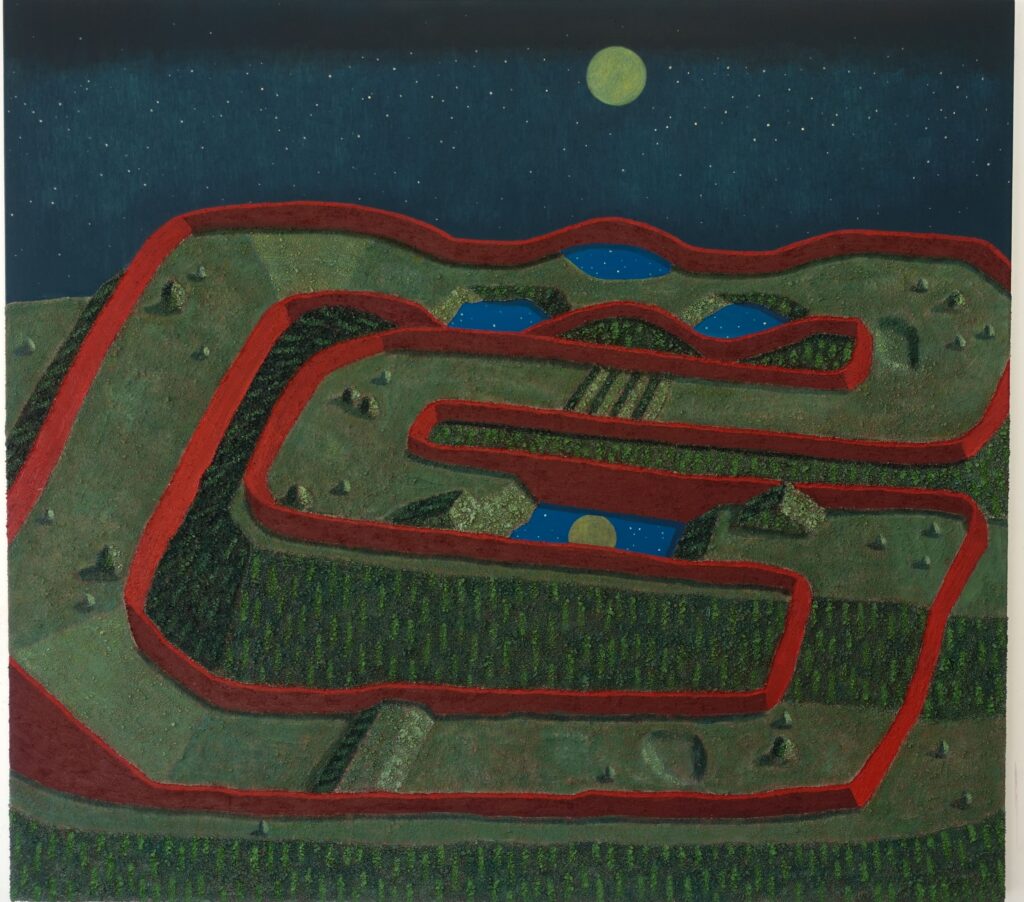
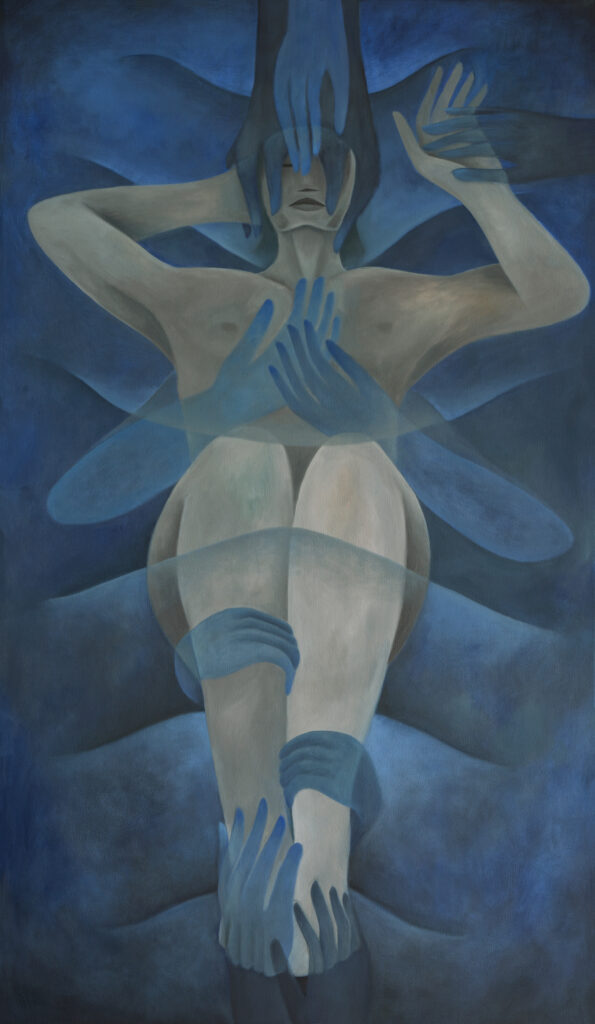
Laura Berger
Night Thoughts, 2023
Oil on Canvas
cm 122 x 71
SOLD
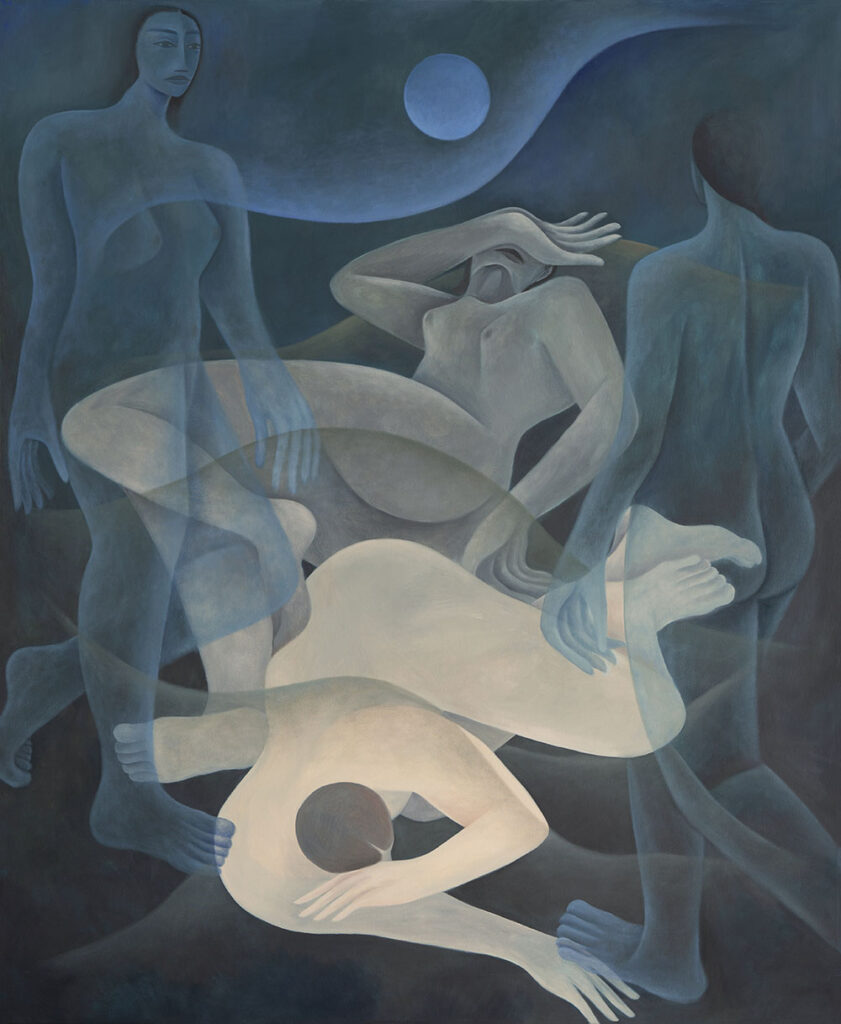
Laura Berger
The Sleepwalkers, 2023
Oil on Canvas
cm 141 x 117
SOLD
A similar space-time suspension surrounds the work of Jonathan Ryan, who depicts a terraced landscape under a starry sky, a desert area with no men nor women. The fictional landscape of Emerald Mesa is a metaphysical and tactile place, with its grainy texture due to the use of sand mixed with oil painting. The fields are tidy and green, the land is lush as if someone had taken care of it every day, until the sun goes down. In this sleeping landscape, only the moon moves and vibrates reflecting itself in small water mirrors. The plays of reflections create an ambiguous dimensional shifting between sky and ground surface, and from the aerial perspective the green hill rather looks like a satellite sailing through space.
Alexis Jang instead, with her vivid and bright painting, creates surrealistic nocturnes whit strange figure indiscreetly peering into viewer’s eyes. In Four Clouds the feline gaze, with its ability to see in the dark, recalls the lines of a poem by Charles Baudelaire (Le Fleurs du Mal), who wrote that cats can “sift the silence and the most frightening darkness”, a metaphor for intellectuals and poet as stealthy watcher of contemporary life; in Windswept Bonnet the artist suggests the principle of the human-nature symbiosis, which begins with the metamorphosis of a woman into a wind-rocked cypress. Once again everything is possible overnight, and the boundaries between imagination and reality are blurred.
In the end, this symbiosis process ends up with the dissolution of the figurative language into the whirling and subtle strands of Sasha Ferrè’s painting. In the work Fluence (Blue), the artist seems to dissect the night atmosphere into tiny particles, as if she were looking through the darkness with a microscopic and yet cosmic gaze. Ferrè seeks the heart of dimness trying to reach, in the depth of night, that moment when things – human kind, plant and animal species – are tied and intertwined together over time. Artist’s depiction of night is a sequence of bursts of lights and shadows which evoke the night swarming of life, as life itself is never still and silent. No matter what it’s quivering beneath the painting: things are misleading in the “transfigured night”. The works on display, diverse in pictorial and iconographic choices, reframe and update a classic theme such as the nocturne, rethinking plenty of ancient and modern references. The exhibition is therefore conceived as a score full of counterpoints in dialogue with the intricate movements of Schönberg’s symphony and with the imaginative verses by Dehmel. Music, poetry and painting, for one mysterious hymn to the night. The artists, then, like the poets in Heidegger’s thought, lie awake in the night of the world and in the silence of the images, little sparks in the dark.
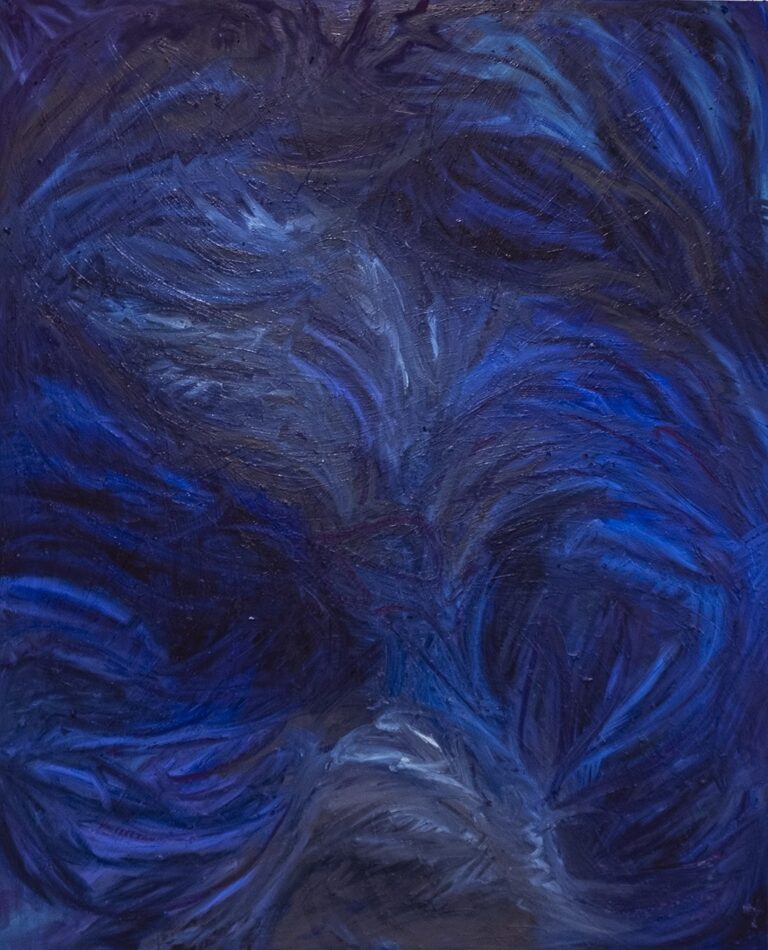
Sasha Ferrè
Fluence (Blue), 2022
Oil on Panel
cm 160×130
All prices are VAT excluded. VAT is applied only for EU buyers

